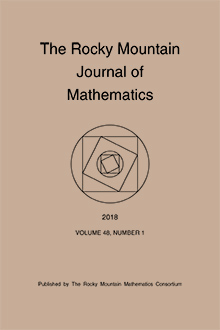Abstract
In this paper, we study a parabolic problem defined in the half line coupled via exponential-type boundary flux. Firstly, we prove the optimal classification of the two components of blow-up solutions when time reaches the blow-up time from left. Blow-up takes place only at the origin, and simultaneous blow-up rates are determined as well. Secondly, we study the weak extension after the blow-up time. Complete blow-up always occurs whether simultaneous blow-up arises or not. Moreover, an instantaneous propagation of the blow-up singularity to the whole spatial domain occurs at the blow-up time, which is the so-called thermal avalanche phenomenon. Finally, we use the evolution of the $k$-level set of solutions in the approximations to characterize the propagation of the singularity.
Citation
Bingchen Liu. Fengjie Li. Mengzhen Dong. "Thermal avalanche after non-simultaneous blow-up in heat equations coupled via nonlinear boundary." Rocky Mountain J. Math. 49 (3) 817 - 847, 2019. https://doi.org/10.1216/RMJ-2019-49-3-817
Information





